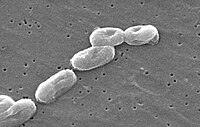
Photo from wikipedia
Abstract Burkholderia cenocepacia is an opportunistic pathogen that causes severe infections of the cystic fibrosis (CF) lung. To acquire iron, B. cenocepacia secretes the Fe(III)-binding compound, ornibactin. Genes for synthesis… Click to show full abstract
Abstract Burkholderia cenocepacia is an opportunistic pathogen that causes severe infections of the cystic fibrosis (CF) lung. To acquire iron, B. cenocepacia secretes the Fe(III)-binding compound, ornibactin. Genes for synthesis and utilisation of ornibactin are served by the iron starvation (IS) extracytoplasmic function (ECF) σ factor, OrbS. Transcription of orbS is regulated in response to the prevailing iron concentration by the ferric uptake regulator (Fur), such that orbS expression is repressed under iron-sufficient conditions. Here we show that, in addition to Fur-mediated regulation of orbS, the OrbS protein itself responds to intracellular iron availability. Substitution of cysteine residues in the C-terminal region of OrbS diminished the ability to respond to Fe(II) in vivo. Accordingly, whilst Fe(II) impaired transcription from and recognition of OrbS-dependent promoters in vitro by inhibiting the binding of OrbS to core RNA polymerase (RNAP), the cysteine-substituted OrbS variant was less responsive to Fe(II). Thus, the cysteine residues within the C-terminal region of OrbS contribute to an iron-sensing motif that serves as an on-board ‘anti-σ factor’ in the presence of Fe(II). A model to account for the presence two regulators (Fur and OrbS) that respond to the same intracellular Fe(II) signal to control ornibactin synthesis and utilisation is discussed.
Journal Title: Nucleic Acids Research
Year Published: 2022
Link to full text (if available)
Share on Social Media: Sign Up to like & get
recommendations!